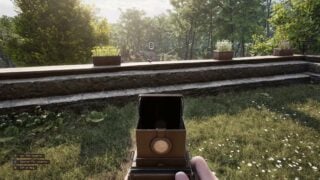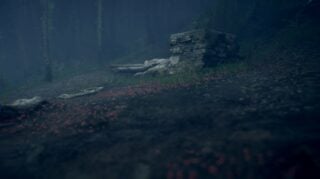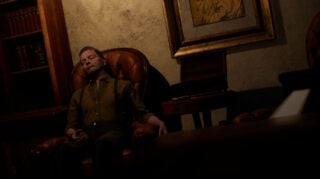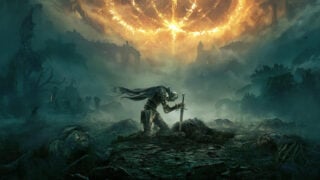Review: Martha is Dead is a deeply disturbing game that isn’t for everyone
This Italian indie offers an equally absorbing and shocking adventure that will stay with players long after the credits roll
- Creative director
- Luca Dalco
- Key Credits
- Alessio Belli (Designer), Lorenzo Conticelli (Lead artist)

A cynic would say that Sony’s apparent demand that Martha is Dead be censored was actually one of the best things that could happen to the game.
It’s fair to say that developer LKA’s horror title was flying under some players’ radars until the news broke last week, and now a level of mystique has surrounded the title, with some wondering exactly what could be so shocking to lead to such actions.
Having now played through the game, we can safely say that although we may not necessarily agree with the decision to cut any part of the game, we can absolutely understand why such a decision was made. Put bluntly, Martha is Dead is one of the darkest games we’ve ever played.
The story opens with the protagonist Giulia discovering her sister Martha’s corpse lying in the river near their house. Already, we can’t say much more than this, because there’s a fairly big twist right at the start of the game that has a huge impact on how both the player and Giulia will handle the rest of the story.
Needless to say, however, the majority of the game focuses on trying to find out exactly what happened to Martha and who was responsible for her death.
The entire game is played in a first-person perspective, and could be lazily described as a walking simulator, albeit one with a little more freedom than most. While there’s still a fairly linear story to follow there are also a series of side quests that can be discovered and optionally taken on.
They’re worth tracking down, too, because the main story will only take around 4-5 hours to complete and this is a compelling world that deserves to be inhabited for longer than that.
The house where much of the game is set – located in the middle of Tuscan woodlands – is beautifully detailed, its 1944 setting making for a wonderful time capsule. Every room has been designed with great care and attention to detail, and by the end of the game you feel like you know the house inside-out.
Its wartime setting is also expertly handled, keeping the player abreast of what’s going on without forcing it down their throat. Radios are left on in certain rooms, with broadcasts giving updates, while there’s a side-quest that involves reading the newspaper every day to see how it’s covering both Martha’s death and the war in general.
This is all supported by a phenomenal soundtrack, consisting of a mix of period-accurate radio music and a more contemporary score, lending extra atmosphere for the most part and really dialling up the discomfort when needed. The game’s most shocking scenes are made all the more awful by their disconcerting music.
But as beautifully detailed as the game is, it’s these shockingly detailed horror scenes and numerous others that will inevitably define Martha is Dead in the discourse that will likely follow after its release. The game’s marketing has been preparing players for a dark experience, but it may come as a surprise just how bleak and graphic the game gets.
In our preview last year we described an early dream sequence that involved physically cutting someone’s face off and putting it over your own – a scene which has since been made non-playable in the PlayStation version – but it turns out that’s just one of a number of key scenes that range from uncomfortable to downright disgusting.
We don’t want to say whether it’s gone too far. The games industry comes in all flavours and genres, and games with mature themes are just as valid as any other. That said, we do at least feel the need to warn players that some of the scenes encountered here may have a lasting negative impact on some players.
“The games industry comes in all flavours and genres, and games with mature themes are just as valid as any other. That said, we do at least feel the need to warn players that some of the scenes encountered here may have a lasting negative impact on some players.”
It’s difficult to go into detail on this without revealing too much in the way of plot information, but if anyone reading this feels they may need a content warning, in the following paragraph we’ll list the types of potential triggers that are encountered in the game.
Warning: potentially distressing content in the following paragraph:
As well as the obvious central plot point of a young woman drowning and the presence of numerous gory and bloody scenes including the aforementioned face-cutting scene, the game also includes such themes as child abuse, animal abuse, mental health issues, abortion, miscarriage, suicide, hanging and self-harm.
Content warning ends.
Not only are these scenes shown in unflinching detail, in some situations the player actually has to take control and carry them out (unless you’re playing on PS4 or PS5, where they play out automatically instead).
We let out an audible laugh as the game’s final scene started and a warning message appeared – the first we’d encountered after the title screen – telling us that the upcoming content involved a certain type of trigger and asked if we wanted a censored version instead.
While it’s admirable that the game would do this because it’s a particularly nasty scene, we did find it darkly amusing that we’d already experienced seen so many extremely graphic things up to that point, and that it was all of a sudden warning us right at the end that we might not want to see the next bit.

While we’d argue that the game’s grim subject matter absolutely has the right to exist, some of it does feel rather gratuitous and doesn’t actually contribute anything to the plot, as if it was thrown in there for shock value alone.
This is particularly notable during the final scene in which the narrated voiceover throws in one exceptionally graphic description of a certain act, for seemingly no reason whatsoever other than to add a final helping of grot with a couple of minutes to go.
Incidentally, not only does the PlayStation version remove the interactivity in some scenes, it also offers players the choice to play a ‘censored’ version of the game. This outright removes some scenes. It also completely removes the final narration we just referred to, suggesting it wasn’t essential to the plot.
Putting aside its controversial content, the rest of the game itself isn’t entirely without issue, though its negative points are fairly minor and don’t detract from the overall experience.
While exploring the house is a joy, we were slightly less enthused when wandering around the nearby forest, which is a bit too large for our liking considering how relatively few and far between its points of interest are for the most part.
Giulia also walks incredibly slowly, meaning players will find themselves holding down the LB/L1 button to run the majority of the time. We’d have liked the option to toggle running on permanently.
“Not only does the PlayStation version remove the interactivity in some scenes, it also offers players the choice to play a ‘censored’ version of the game. This outright removes some scenes.”
Still, the game’s slow pace certainly builds tension, and it isn’t the sort of tension that doesn’t come with a payoff – there are occasions when you’ll catch glimpses of something unsettling, and while the jump-scares are scarce, they’re effective nonetheless.
While the plot is mainly engaging, a few sections did leave us slightly underwhelmed, especially one scene in which the game’s initial twist is discovered by other characters. We expected a more dramatic revelation at this point but the whole thing felt rather flat, especially because much of it was simply described through narration rather than actually shown.
Without spoiling anything, the game’s final moments, in which players quite literally decide their own ending, may also feel like a bit of a cop-out to some, and its slightly throwaway attempt to put a silver lining on its subject matter right at the end may not make up for the distress some may feel.
This aside, the misfires don’t detract too much from the overall game and there’s still a lot to do here, as long as you make the effort to look for it.

The player is encouraged to look at everything in the house and its surroundings, as some objects can trigger side-quests. The same goes for the numerous items which can be photographed – Guilia is a keen photographer, and taking photos of certain things, particularly in the woods, can also lead to new missions.
When all was said and done, as the credits rolled on Martha is Dead (and we listened to its beautifully haunting credits theme), we sat there for a while trying to digest what we’d just played. We’re desperately curious – more than with any other game in recent memory – to see how this game will be addressed and discussed when it’s released and a wider audience gets its hands on it.
While some players will claim it to be an important game that deals with difficult subjects and is essential in pushing the medium forward, there will doubtless be others who will believe it goes too far.
Depending on your stance, it’ll either feel like the video game equivalent of arthouse cinema – often stark and shocking but important – or of the ‘80s video nasty movies that masqueraded as deep and thought-provoking but were ultimately designed to outrage first and foremost.
“Depending on your stance, it’ll either feel like the video game equivalent of arthouse cinema – often stark and shocking but important – or of the ‘80s video nasty movies that masqueraded as deep and thought-provoking but were ultimately designed to outrage first and foremost.”
It may sound like we are angry at this game. Quite the contrary. We believe that if you have the stomach for it, Martha is Dead is certainly worth experiencing.
We certainly haven’t played anything like it – What Remains of Edith Finch and the studio’s previous title The Town of Light are the closest we can think of, but this goes significantly further in terms of its graphic imagery.
Ultimately, then, we recommend it, but only to those who feel they’ll be able to handle it. If any of the themes or subject matter we listed earlier in the review affect you in a serious way, you should give this a miss, because they’re shown in unflinching detail.
If you’re confident that you can get through the other side relatively unscathed, however, then Martha is Dead is a haunting and absorbing adventure that will stay with you long after the credits roll, as you try to piece together exactly what did happen and what the true ending really was.
As long as you can withstand its often extremely disturbing content, Martha is Dead is a absorbing and atmospheric adventure with a brilliantly realised setting and a beautifully haunting soundtrack. We can’t stress enough that it won’t suit all tastes, however.
- A beautifully detailed setting to explore
- A haunting, perfectly judged soundtrack
- An engaging plot that remains in your head long after the credits
- Its disturbing themes and graphic imagery will be too far for some
- Some story beats fall a little flat





















